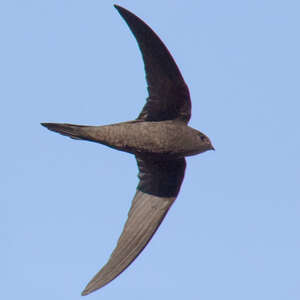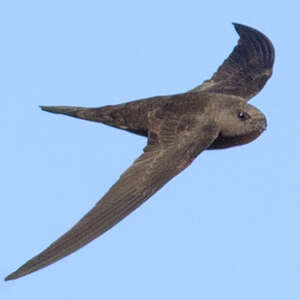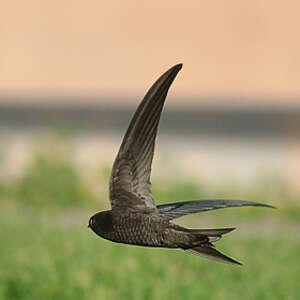Plain Swift
Apus unicolor - Martinet unicolore
Identification
The Plain Swift is very similar to the Common Swift (Apus apus). It can be distinguished by a slightly smaller size, more acute forking at the tail, and a much smaller (often seemingly absent) white spot on the chin. In places where these two species and the Pallid Swift (Apus pallidus) are present, the identification of one or the other requires attention when observed alone. However, if the species are present together, the identification is easier.
Subspecific information monotypic species
Foreign names
- Martinet unicolore,
- Vencejo unicolor,
- andorinhão-da-serra,
- Einfarbsegler,
- egyszínű sarlósfecske,
- Madeiragierzwaluw,
- Rondone unicolore,
- enfärgad seglare,
- Kanariseiler,
- dážďovník morský,
- rorýs jednobarvý,
- Ensfarvet Sejler,
- madeirankiitäjä,
- falciot unicolor,
- Niðsvölungur,
- jerzyk jednobarwny,
- vienmuļā svīre,
- enobarvni hudournik,
- Одноцветный стриж,
- ハイイロアマツバメ,
- 纯色雨燕,
- 純色雨燕,
Voice song and call
Habitat
Behaviour character trait
Part of the Plain Swift population appears to be sedentary. At least, the species is visible throughout the year, though in smaller numbers during the winter. It seems that part of the birds winter in the south coasts of Morocco. The general behaviour is similar to that of the Black Swift, in both its hunting habits and loud chase. Often seen in the company of the other two species present in the islands, this is a gregarious species.
Flight
Reproduction nesting
The Plain Swift is a colonial species. Its nests are usually built in deep crevices of maritime and continental cliffs, much more rarely under bridges or in houses. They are made of pieces of grass and feathers bonded by saliva. The laying is usually two eggs. Almost nothing is known about the reproductive biology of this species. It seems that both sexes incubate and that there are often two clutches.
Threats - protection
Sources of information
- IOC World Bird List (v15.1), Gill, F and D Donsker (Eds). 2025-12-07.
Other sources of interest
 Specification sheet created on
30/07/2023 by Georges Olioso
Specification sheet created on
30/07/2023 by Georges OliosoTranslation by AI Oiseaux.net
© 1996-2026 Oiseaux.net
- Accipitriformes
- Aegotheliformes
- Anseriformes
- Apodiformes
- Apterygiformes
- Bucerotiformes
- Caprimulgiformes
- Cariamiformes
- Casuariiformes
- Charadriiformes
- Ciconiiformes
- Coliiformes
- Columbiformes
- Coraciiformes
- Cuculiformes
- Eurypygiformes
- Falconiformes
- Galliformes
- Gaviiformes
- Gruiformes
- Leptosomiformes
- Mesitornithiformes
- Musophagiformes
- Nyctibiiformes
- Opisthocomiformes
- Otidiformes
- Passeriformes
- Pelecaniformes
- Phaethontiformes
- Phoenicopteriformes
- Piciformes
- Podargiformes
- Podicipediformes
- Procellariiformes
- Psittaciformes
- Pterocliformes
- Rheiformes
- Sphenisciformes
- Steatornithiformes
- Strigiformes
- Struthioniformes
- Suliformes
- Tinamiformes
- Trogoniformes

























